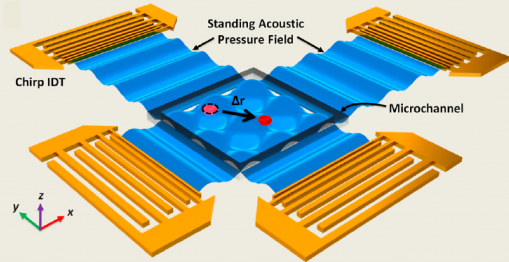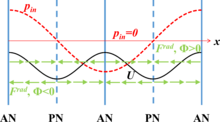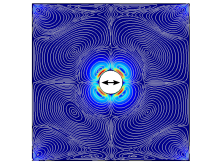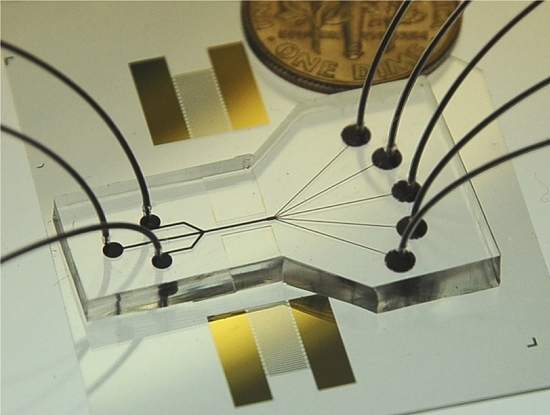Sections
Acoustic Tweezers is a simple technology which is used to control object movement using the sound waves. In the presence of the acoustic field, most of the objects will be having a radiation force which is acoustic in nature and it helps to move the objects in special regions of the acoustic field. Now based on the object properties, these can be moved to the acoustic pressure. Due to this, manipulation of the objects is feasible simply by controlling the pressure nodes.

These acoustic tweezers does not require the need of any expensive equipments and any other complex experimental set ups. This is an ideal tool for many biomedical applications. Also, tweezers found applications in flow cytometery, cell trapping, cell separation, nanomaterial manipulation and single cell manipulation.
In the acoustic field, particles are moved by the forces being generated from the waves, fluid and particles. Apart from these forces, acoustic radiation, secondary field force between particles etc. will together create the acoustophoresis phenomenon which is the basis of acoustic tweezers technology.
Acoustic radiation force comes into action when a particle gets suspended in the sound wave field. This force comes into action due to the acoustic waves scattering on the particle. The force was first studied on incompressible particles of an ideal fluid in the year 1934. Later on in 1955, the study was carried on compressible particles in a plane wave field.
Gorkov and Bruus came up with equations and derivations for the acoustic radiation force.

In the figure, acoustic radiation force on a particle results due to the non-uniform flux of momentum in the near field region that comes around the particle.

This force is caused by the acoustic waves that are incoming and the scattering on surface particle when the waves propagate through it. For a compressible particle which is spherical in nature, the acoustic radiation force is given by:

Here U is defined as the acoustic potential energy.
The acoustic potential energy is given as:

where

The two coefficients f1 and f2 can be calculated by ,
Where


Standing waves produce an acoustic potential energy field which is stable so that the force distribution created is stable. For one dimensional planar standing waves the acoustic field is given by:
Where





Thus, the acoustic potential energy is:

By differentiating, the acoustic radiation force is obtained by;



where Eac is the acoustic energy density, and Ø is acoustophoretic contrast factor. The term known as sin(2kx) tells that the radiation force time period is half of the period of pressure. Here the contrast factor can be negative or positive based on the properties of the fluids and particles. When Ø has a positive value, the force of radiation points from the pressure antinodes to the pressure nodes. In the figure, the particles are pushed to the pressure nodes.
When particles in suspension are being exposed to the standing wave field, an acoustic radiation force is being experienced and at the same time secondary acoustic forces are being caused by the waves being scattered from the particles. The forces in the particle are known as Bjerknes forces.
The interparticle forces are represented by:

where
• alpha is the radius of the particle,
• thetta is the angle between the central line of the particles and the direction of propagation of the incident acoustic wave.
• d is the distance between the particles,
Here the sign of the force represents the direction. A negative sign indicates the attractive interparticle force. While, positive sign indicates a repulsive action. Right side of the equation depends upon the pressure amplitude of the acoustic particle and the left side of equation depends upon the velocity amplitude of acoustic particle.
When the particles come in the acoustic wave propagation direction, the term depending on velocity will become repulsive. And the same term becomes attractive when the particles become perpendicular to the incident wave propagating. The term which is dependent on the pressure is not affected by the orientation of the particle. This term will be always attractive.
Velocity depending term will be diminished as the particles move to the velocity node. While, the pressure dependent term diminishes as the particle moves towards the pressure node.

Acoustic streaming is a steady flow that is generated by the nonlinear effect in the acoustic field.
Two types of acoustic streaming are:
Eckert streaming is caused by the time- average momentum flux which is created due to the high amplitude acoustic wave propagating and attenuating in the fluid.
While Rayleigh streaming also known as Boundary driven streaming is forced by the shear viscosity close to the solid boundary.
Particle motion
Motion of any suspended particle with the gravity being balanced by the buoyance force is determined by the two forces:
Using the Newton’s law, the motion can be described as:


where
• u is the velocity of particle.
• v is the fluid velocity.
In static flow applications, fluid velocity comes from the acoustic streaming. Magnitude of the acoustic streaming depends upon the frequency, fluid media and power of the input. Magnitude of the acoustic streaming comes in the range of 1 µm/s~ 1 mm/s.
Label-free cell separation.
Fluorescence-activated cell sorting.
Noninvasive cell trapping and patterning.
Manipulation of single cell, particle, or organism.
Manipulation of single (bio) molecules.
Manipulation of organic nanomaterials.
Manipulation of inorganic nanomaterials.
Researchers of Penn State University has developed a new technique which uses sound or waves to do cell sorting on the chip which leads to the development of diagnosing medical devices. Here this technology uses the beams of sound waves to sort the cells on the chip which is approximately the size of the dime.

With change in frequency of the sound waves, the cells are being filtered into 5 channel or more channels. The present cell sorting technologies can help in the sorting of cells into two channels only at the maximum.
Huang and his team developed a sound or acoustic cell sorting chip which was created using the silicone layer and parallel transducers which helps in the conversion of AC into sound waves. These transducers are placed at the chip sides. As the sound waves starts to interfere with each other, pressure nodes are formed on the chip and also as the cells starts to cross the chip, they will get channeled towards the pressure nodes.
Testing of the device was done by sorting a beam of polystyrene fluorescent beads into 3 channels. The team was able to slow the particles that flow across the chip unhindered prior to turn ON the transducer. Now when the transducer starts producing the sound waves, the particles get separated into the channels. The research team was able to sort the human WBC affected by leukemia.
Sections